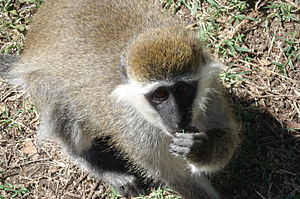Ethiopian vervet monkey
| Ethiopian vervet monkey | ||||||||||||
|---|---|---|---|---|---|---|---|---|---|---|---|---|

Ethiopian vervet monkey ( Chlorocebus aethiops ) |
||||||||||||
| Systematics | ||||||||||||
|
||||||||||||
| Scientific name | ||||||||||||
| Chlorocebus aethiops | ||||||||||||
| ( Linnaeus , 1758) |
The Ethiopian vervet monkey ( Chlorocebus aethiops ) is a species of primate from the family of vervet monkeys (Cercopithecidae). It is one of the six species in which the vervet monkeys are differentiated in the more recent classifications.
features
These monkeys reach a head body length of 40 to 60 centimeters and a tail length of up to 70 centimeters and a weight of 4 to 6 kilograms, whereby the males are significantly heavier than the females. The color of their fur varies from yellowish to green-brown on the upper side, the underside is white, the hands and feet are colored black. The face is also black, and there are white stripes of fur on the forehead and cheeks.
distribution and habitat
Ethiopian green monkeys live in northeastern Africa , their range includes Sudan and South Sudan east of the White Nile as well as Ethiopia and Eritrea . They are not particularly picky about their habitat and are found in sparse forests and savannas. However, they are dependent on sleeping trees.
Way of life
Like all Old World monkeys, these animals are diurnal and can be found both in the trees and on the ground. They live in large groups that consist of a few males, many females and their offspring. In the groups, males and females establish a distinctive hierarchy, which is expressed, among other things, in access to food resources and mutual grooming.
They are omnivores , and although they prefer to eat fruits and flowers, they can also eat other parts of plants and small animals if necessary.
threat
Hunting and habitat destruction are believed to be the main threat to this species. However, exact details are not possible, the IUCN does not list the individual species of green monkeys separately.
The animals were used to obtain vaccines against measles and polio and are considered to be a possible carrier of the Marburg virus to humans and thus the cause of the first outbreak of Marburg fever in the Behringer works near Marburg in 1967. A total of 600 animals were then found in Marburg, Frankfurt and Belgrade killed by hydrogen cyanide.
Systematics
In the past, all vervet monkeys on the African continent were grouped into a single species, which bore the scientific name Chlorocebus aethiops (formerly Cercopithecus aethiops ). Today, six species are distinguished on the basis of morphological criteria, whereby the Ethiopian vervet monkey continues to retain this scientific name as a type species . The use of this name is therefore ambiguous and depends on the systematic point of view.
literature
- Thomas Geissmann : Comparative Primatology. Springer-Verlag, Berlin et al. 2003, ISBN 3-540-43645-6 .
- Ronald M. Nowak: Walker's Mammals of the World. 6th edition. Johns Hopkins University Press, Baltimore MD 1999, ISBN 0-8018-5789-9 .
Web links
- KA Cawthon Lang: Primate Factsheets: Vervet ( Chlorocebus sp. )
- Chlorocebus aethiops inthe IUCN 2013 Red List of Threatened Species . Submitted by: Kingdon, J. & Butynski, TM, 2008. Retrieved January 22, 2014.
